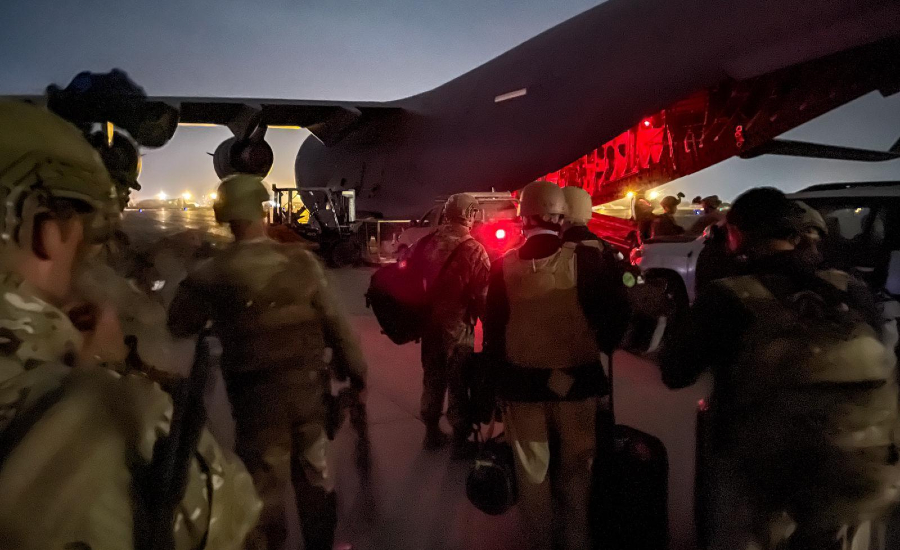The Big Unanswered Question of the Afghanistan War
Does the United States still have the grit necessary to fight and win long wars?

Published by The Lawfare Institute
in Cooperation With

Editor’s Note: What does the U.S. departure from Afghanistan imply for future wars? Rand Corp.’s Raphael Cohen argues that the Afghanistan withdrawal illustrates a critical U.S. weakness: a lack of staying power. He contends this weakness could prove devastating in future confrontations with Russia, China or other powers.
Daniel Byman
***
The United States’ war in Afghanistan may be over, but the debate over the legacy of America’s longest war has just begun. Congress has already promised to investigate the U.S. exit in the coming months. Long after the political world moves on, scholars and soldiers still will be dissecting the two-decade-long war. And the U.S. defeat in Afghanistan raises many questions for these postmortems to explore: Why did the United States lose? Who was to blame? And what comes next for Afghanistan, for the United States, and the world at large? Yet for the future of American defense strategy, perhaps, one big question stands out above all: Does the United States still have the grit necessary to fight and win long wars anymore?
The war in Afghanistan, at its core, was a war of endurance. While there is a lot of focus on the United States’ lack of cultural understanding as the key to its defeat, the fact is that insurgencies, rarely, if ever, are won by “winning hearts and minds.” Rather, they are mostly snuffed out quickly, often with force. If the insurgents are disciplined, have access to external sanctuaries, or enjoy foreign backers, insurgencies can last for decades. In those cases, the governments win only once they eventually either crush the opposition, like Sri Lanka did with the Tamil Tigers, or exhaust them to the point that they seek peace, as with the Irish Republican Army or the Revolutionary Armed Forces of Colombia. Ultimately, these wars come down to a battle of wills, and the side with stronger will prevails.
This is how the Taliban succeeded. Neither crushed nor exhausted, they ground the United States, its allies and the Afghan government down year after year. In the end, the Afghan military evaporated and the Afghan government fled rather than fight—a fact that has become central to the United States’ post-hoc justification of its withdrawal. As President Biden argued, “American troops cannot and should not be fighting in a war and dying in a war that Afghan forces are not willing to fight for themselves.” But before Americans cast stones, it’s worth noting that Afghanistan lost 66,000 soldiers and policemen—not to mention civilians—over the past two decades. That’s more than the United States did in Vietnam, and Afghanistan today has a fifth the population that the United States had during that war, magnifying the human impact of the conflict.
Afghanistan was not the only country whose stamina gave out by the end. The United States also had lost the will to fight. While President Biden, a Democrat, ultimately oversaw the defeat, he was executing a deal negotiated by his predecessor, President Trump, a Republican. And both were, arguably, fulfilling the will of the American people. According to a Washington Post-ABC News poll, more than three-quarters of the American public still support withdrawal, even after the debacle of the exit was reported with vivid images in prime time in recent weeks.
What’s striking about the collapse in popular support for the Afghanistan War is how minimal the U.S. commitment was in absolute terms over the past few years. Yes, the United States spent 20 years in the country, invested more than a trillion dollars in the war, sent hundreds of thousands of service members to fight in the war and lost more than 2,500 of them. The vast majority of this commitment, however, came during the first decade of the conflict. The United States had only 15,500 troops in Afghanistan—all of them volunteers—when Trump decided to cut his deal; the deployment represented only about only half a percent of the total U.S. military. The United States lost fewer than 100 soldiers in the five years leading up to the withdrawal; more soldiers died in training accidents than died in combat in Afghanistan in the last years of the war. Americans were not forced to serve in the war. Higher taxes were not sought to pay for the war. Americans also were spared constant exposure to the war. The major networks spent only about five minutes of airtime on the conflict in 2020, the year before the withdrawal.
In exchange for this modest investment, the United States reaped an equally modest reward. It kept international Islamic terrorism emanating from Afghanistan in check, gave some semblance of democracy and human rights to millions of Afghans, and complicated the strategic picture for China and Russia—which now had a NATO presence next door. In the end, though, the United States collectively decided that this return on investment did not warrant the price tag.
The U.S. war in Afghanistan is over, and Washington is moving on. In a few months, the Biden administration will release a new National Security Strategy and a new National Defense Strategy. Like its predecessors, the defense strategy will likely focus on the threat posed by China and Russia (along with a healthy dose of nontraditional threats like pandemics and climate change) and downplay the threat of international terrorism. The defense analytical community will follow suit, focusing on the posture, capabilities and concepts needed to win the next war.
And yet, in all of these new debates, the shadow of Afghanistan will remain. The unquantifiable variable in any model of future conflict is the will to fight. Without it, the hardware of war—all the planes, tanks and ships—is meaningless and all the clever concepts are simply theoretical. And after the U.S. defeat, any assessment of the American will to fight in any future great power war must end with a question mark.
Even under the best of circumstances, these future wars likely would be a herculean test of American willpower. A war with China over Taiwan or Russia over the Baltics would be militarily far more difficult than the war in Afghanistan or Iraq, and the economic devastation and casualties of these future wars could be orders of magnitude greater than what the United States experienced during the global war on terrorism. And victory in these future wars is more uncertain than was victory in Afghanistan.
Whether the United States has the stomach for these fights is not immediately clear. In the most recent surveys, only a slim majority—52 percent of Americans—support using force if China attacks Taiwan, and historically the percentage has been far lower. A similarly narrow majority of Americans have a favorable view of NATO, although a somewhat greater percentage of Americans support using force if Russia attacks a NATO member.
Going forward, any future U.S. military intervention also will need to contend with the legacy of Afghanistan. Even if the war is over, the antibodies generated from the conflict—and more broadly from the war on terrorism—will remain in the American strategic discourse for some time. After all, the various groups that mobilized against the global war on terrorism are not going away, even if the wars themselves have ended. Even before the Afghanistan withdrawal, polls also suggested that significant swaths of the American public from across the political spectrum preferred a less militarized and more restrained foreign policy going forward. Now that the Afghanistan defeat has stripped bare the failings of American military strategy, these percentages may increase.
On a more fundamental level, Afghanistan may engrain American aversion to “forever wars.” While Americans may prefer repeats of the first Gulf War—a few days of fighting, resulting in a decisive victory and concluding with a parade at the end—this is unlikely to be the future of warfare. China and Russia are big, powerful countries and would have a lot at stake—from national prestige to their security to potentially regime survival—if they ever fought wars over Taiwan or Eastern Europe. Even if the United States and its allies prevail in the opening phases then, China and Russia are unlikely to simply quit. These conflicts could drag on for years if not decades. In other words, unless they end in nuclear oblivion first, these conflicts might also be “forever wars.”
And so, the question has to be whether the United States will have more fortitude in future “forever wars” than it did in this last one, or whether, as time wears on, Americans will eventually say that a democratic Taiwan or a Europe “whole, free and at peace” is just not worth the price. The sake of the international order and the fate of liberal democracy could turn on the answer to that question.




